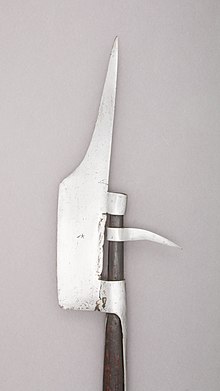Halberd
Ahalberd(also calledhalbard,halbertorSwiss voulge) is a two-handedpolearmthat came to prominent use from the 13th to 16th centuries. The halberd consists of anaxeblade topped with a spike mounted on a long shaft. It can have a hook or thorn on the back side of the axe blade for grapplingmounted combatants.[2]The halberd was usually 1.5 to 1.8 metres (4.9 to 5.9 ft) long.[3]
The wordhalberdiscognatewith the German wordHellebarde,deriving fromMiddle High Germanhalm(handle) andbarte(battleaxe) joined to formhelmbarte.Troops that used the weapon were calledhalberdiers.The word has also been used to describe a weapon of the early Bronze Age in Western Europe. This consisted of a blade mounted on a pole at a right angle.[4][5]
History[edit]

The halberd is first mentioned (ashallenbarte) in a work by 13th-century German poetKonrad von Würzburg.[6]John of Winterthurdescribed it as a new weapon used by theSwissat theBattle of Morgartenof 1315.[6]The halberd was inexpensive to produce and very versatile in battle. As the halberd was eventually refined, its point was more fully developed to allow it to better deal withspearsandpikes(and make it able to push back approaching horsemen), as was the hook opposite the axe head, which could be used to pull horsemen to the ground.[7]A Swiss peasant used a halberd to killCharles the Bold,[8]theDuke of Burgundy,at theBattle of Nancy,decisively ending theBurgundian Wars.[9]

The halberd was the primary weapon of the early Swiss armies in the 14th and early 15th centuries.[7]Later, the Swiss added thepiketo better repelknightlyattacks and roll over enemy infantry formations, with the halberd,hand-and-a-half sword,or thedaggerknown as theSchweizerdolchused for closer combat. The GermanLandsknechte,who imitated Swiss warfare methods, also used the pike, supplemented by the halberd—but theirside armof choice was ashort swordcalled theKatzbalger.[10]
As long as pikemen fought other pikemen, the halberd remained a useful supplemental weapon forpush of pike,but when their position became more defensive, to protect the slow-loadingarquebusiersandmatchlockmusketeers from sudden attacks bycavalry,the percentage of halberdiers in the pike units steadily decreased. By 1588, official Dutch infantry composition was down to 39% arquebuses, 34% pikes, 13% muskets, 9% halberds, and 2% one-handed swords. By 1600, troops armed exclusively with swords were no longer used and the halberd was only used by sergeants.[11]
Researchers suspected that a halberd or abillsliced through the back of KingRichard III's skull at theBattle of Bosworth Fieldon 22 August 1485, leaving his brain visible before killing him during the battle, and were able to later confirm that it was a halberd.[12][13]
While rarer than it had been from the late 15th to mid-16th centuries, the halberd was still used infrequently as an infantry weapon well into the mid-17th century. The armies of theCatholic Leaguein 1625, for example, had halberdiers comprising 7% of infantry units, with musketeers comprising 58% and armored pikemen 35%. By 1627 this had changed to 65% muskets, 20% pikes, and 15% halberds.[14]A near-contemporary depiction of the 1665Battle of Montes ClarosatPalace of the Marquises of Fronteiradepicts a minority of the Portuguese and Spanish soldiers as armed with halberds.Antonio de Pereda's 1635 paintingEl Socorro a Génovadepicting theRelief of Genoahas all the soldiers armed with halberds. The most consistent users of the halberd in theThirty Years' Warwere German sergeants who would carry one as a sign of rank. While they could use them in melee combat, more often they were used for dressing the ranks by grasping the shaft in both hands and pushing it against several men simultaneously. They could also be used to push pikes or muskets up or down, especially to stop overexcited musketeers from firing prematurely.[15]
The halberd has been used as a court bodyguard weapon for centuries, and is still theceremonial weaponof theSwiss Guardin theVatican[16]and theAlabarderos(Halberdiers) Company[17]of theSpanish Royal Guard.[18]The halberd was one of the polearms sometimes carried by lower-ranking officers in European infantry units in the 16th through 18th centuries. In the British army,sergeantscontinued to carry halberds until 1793, when they were replaced byspontoons.[19]The 18th-century halberd had, however, become simply a symbol of rank with no sharpened edge and insufficient strength to use as a weapon.[20]It served as an instrument for ensuring that infantrymen in ranks stood correctly aligned with each other and that their muskets were aimed at the correct level.[21]
The development of the halberd[edit]

The wordhelmbarteor variations thereof show up in German texts from the 13th century onwards. At that point, the halberd is not too distinct from other types of broad axes orbardichesused all over Europe. In the late 13th century the weapon starts to develop into a distinct weapon, with the top of the blade developing into a more acute thrusting point. This form of the halberd is errorenously sometimes called avoulgeor aswiss voulge,but there is no evidence for the usage of these terms for this weapon historically.[22]There were variations of these weapons with spikes on the back, though also plenty without. In the early 15th century the construction changes to incorporate sockets into the blade, instead of hoops as the previous designs had. With this development back spikes are directly integrated into the blade construction and become a universal part of the halberd design.[23]
[edit]

- Bardiche,a type of two-handedbattle axeknown in the 16th and 17th centuries in Eastern Europe
- Bill,similar to a halberd but with a hooked blade form
- Geor dagger-axe,a Chinese weapon in use from theShang dynasty(est. 1500 BC) that had a dagger-shaped blade mounted perpendicular to a spearhead
- Fauchard,a curved blade atop a 2 m (6 ft 7 in) pole that was used in Europe between the 11th and 14th centuries
- Guisarme,a medieval bladed weapon on the end of a long pole; later designs implemented a small reverse spike on the back of the blade
- Glaive,a large blade, up to 45 cm (18 in) long, on the end of a 2 m (6 ft 7 in) pole
- Guandao,a Chinese polearm from the 3rd century AD that had a heavy curved blade with a spike at the back
- Ji( kích ), a Chinese polearm combining a spear anddagger-axe
- Kamayari,a Japanese spear with blade offshoots
- Lochaber axe,a Scottish weapon that had a heavy blade attached to a pole in a similar fashion to avoulge
- Naginata,a Japanese weapon that had a 30-to-60-centimetre-long (12 to 24 in) blade attached by a sword guard to a wooden shaft
- Partisan,a large double-bladed spearhead mounted on a long shaft that had protrusions on either side forparryingsword thrusts
- Poleaxe,a type of polearm with anaxeheadorhammerheadon the sides with either a spike orspearheadat the top and mounted on a long shaft. It was developed in the 14th century and remained in use until the 16th century to breach theplate armourworn by Europeanknightsandmen-at-arms
- Ranseur,a polearm consisting of a spearhead affixed with a cross hilt at its base derived from the earlierspetum
- Spontoon,a 17th-century weapon that consisted of a large blade with two side blades mounted on a long 2 m (6 ft 7 in) pole, considered a more elaboratepike
- Voulge,a crude single-edged blade bound to a wooden shaft
- Tabarzin,a type of battle axe from Middle East.
- War scythe,an improvised weapon that consisted of a blade from ascytheattached vertically to a shaft
- Welsh hook,similar to a halberd and thought to originate from a forest-bill
- Woldo,A Korean polearm that had a crescent-shaped blade mounted on a long shaft, similar in construction to the Chineseguandao,and primarily served as a symbol of the Royal Guard
- Yue, a Chinese axe with long shaft.
Gallery[edit]
-
Different sorts of halberds and halberd-like polearms in Switzerland
-
Citizens ofZürichon 1 May 1351 are read the Federal Charter as they swear allegiance to representatives of Uri, Schwyz, Unterwalden and Lucerne. One of the representatives carries a typical Swiss halberd of the period depicted (as opposed to the time the image was made, 1515).
-
Saint Wiboradais often (anachronistically) depicted with a halberd to indicate the means of her martyrdom.
-
Alabardero(Halberdier) of theSpanish Royal Guard
See also[edit]
References[edit]
- ^"Théâtre de tous les peuples et nations de la terre avec leurs habits et ornemens divers, tant anciens que modernes, diligemment depeints au naturel par Luc Dheere peintre et sculpteur Gantois[manuscript]".lib.ugent.be.Retrieved2020-08-25.
- ^Guilmartin, John F. Jr."Military technology – Britannica Online Encyclopedia".Britannica.com.Retrieved2013-06-13.
- ^"Halberd – Britannica Online Encyclopedia".Britannica.com.Retrieved2013-06-13.
- ^O'Flaherty, Ronan (1998)."The Early Bronze Age Halberd: A History of Research and a Brief Guide to the Sources".The Journal of the Royal Society of Antiquaries of Ireland.128:74–94.JSTOR25549844.
- ^A CONSIDERATION OF THE EARLY BRONZE AGE HALBERD IN IRELAND Function and Context by Ronan O'Flaherty, M.A. A thesis submitted in fulfillment of the requirements for the degree of PhD. UNIVERSITY COLLEGE DUBLIN 2002 Supervisors: Professor Barry Raftery and Dr. Joanna Brück. DEPARTMENT OF ARCHAEOLOGY FACULTY OF ARTS
- ^abJürg A. Meier:HalberdinGerman,FrenchandItalianin the onlineHistorical Dictionary of Switzerland.
- ^ab"History of Warfare – Land".Historyworld.net.Retrieved2013-06-13.
- ^Klaus Schelle,Charles le Téméraire(Arthème Fayard, 1979), p. 316
- ^Gilbert, Adrian (2003) [2002]."Medieval Warfare".The Encyclopedia of Warfare: From Earliest Times to the Present Day.Guildford, CT: The Lyons Press. p.71.ISBN1-59228-027-7.
At Nancy, it was a halberd that brought down Charles the Bold with a single blow that split his skull open.
- ^Ramsey, Syed (2016-05-12).Tools of War: History of Weapons in Medieval Times.Vij Books India Pvt Ltd.ISBN9789386019813.
- ^Olaf van Nimwegen. "The Dutch Army and the Military Revolutions, 1588-1688", Boydell: 2010. Page 87.
- ^Richard III dig: Grim clues to the death of a kingBy Greig Watson,BBC News,4 February 2013
- ^"Skull".The Discovery of Richard III.University of Leicester.Retrieved3 December2014.
- ^Guthrie, William. "The Later Thirty Years War: From the Battle of Wittstock to the Treaty of Westphalia." Praeger, Feb. 2003. Page 16.
- ^Wilson, Peter (2009). Europe's Tragedy: A History of the Thirty Years War. Allen Lane. Page 95.
- ^Beam, Christopher (2007-06-06)."What does the Swiss Guard actually do?".Slate.com.Retrieved2014-03-04.
- ^Bueno, Jose M. (1982).Tropas de la Casa Real.BPR Publishers. p. 11.ISBN84-86071-01-1.
- ^"Inicio".guardiareal.org.
- ^David Fraser. "The Grenadier Guards", page 33.ISBN0850452848
- ^Robin May.Wolfe's Army,Osprey Publishing Ltd 1974, page 33
- ^Duffy, Christopher (1998).The Military Experience in the Age of Reason.Wordsworth Editions. p. 123.ISBN1-85326-690-6.
- ^Waldman, John (2005).Hafted Weapons in Medieval and Renaissance Europe The Evolution of European Staff Weapons between 1200 and 1650.Leiden. p. 17.ISBN978-90-474-0757-7.OCLC704633881.
{{cite book}}:CS1 maint: location missing publisher (link) - ^Waldman, John (2005).Hafted Weapons in Medieval and Renaissance Europe The Evolution of European Staff Weapons between 1200 and 1650.Leiden. pp. 17–98.ISBN978-90-474-0757-7.OCLC704633881.
{{cite book}}:CS1 maint: location missing publisher (link)
Bibliography[edit]
- Brandtherm, Dirk & O'Flaherty, Ronan;Prodigal sons: two 'halberds' in the Hunt Museum, Limerick, from Cuenca, Spain and Beyrǔt, Syria,pp. 56–60,JRSAIVol.131 (2001).
- Chisholm, Hugh,ed. (1911)..Encyclopædia Britannica.Vol. 12 (11th ed.). Cambridge University Press. p. 830.
- Lorge, Peter A. (2011),Chinese Martial Arts: From Antiquity to the Twenty-First Century,Cambridge:Cambridge University Press,ISBN978-0-521-87881-4
- O'Flaherty, Ronan;The Early Bronze Age halberd: a history of research and a brief guide to the sources,pp. 74–94,Journal of theRoyal Society of Antiquaries of Ireland,Vol.128 (1998).
- R. E. Oakeshott,European weapons and armour: From the Renaissance to the industrial revolution(1980), 44–48.







